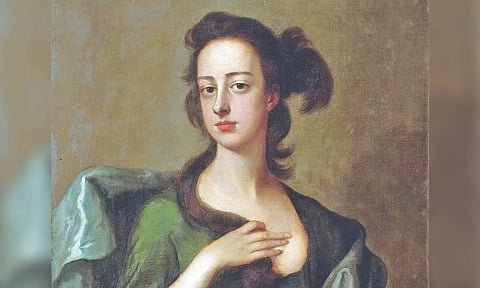

By Alexandra Jacobs
NEW YORK: Margaret Cavendish was an intrepid and prolific writer of the 17th century, who — despite the efforts of many scholars and enthusiasts — is now less well-known than her family’s namesake banana. Reading Francesca Peacock’s cantering new biography “Pure Wit”, I thought of that immortal smackdown from “Mean Girls” (movie, and soon-to-be movie musical): “Gretchen! Stop trying to make ‘fetch’ happen. It’s not going to happen.”
For centuries, people have been trying to make Margaret Cavendish happen — beginning with Margaret Cavendish, born Lucas and educated in “shreds and patches,” who once declared “all I desire is fame.” To that end she wed William, the horsy Marquis of Newcastle 30 years her senior, and — in defiant lieu of children — published poetry, plays, philosophy and prose romances under her own byline, which was very unusual for that era.
Cavendish’s versatility of genre, as well as her gender, surely undermined her bid at a celebrity afterlife; her work could easily be dismissed as dilettantism. Her dynamic if perhaps daffy-sounding theory of matter, a.k.a. “vitalist materialism” — roughly, that inanimate objects may have some element of thought and feeling — presaged Marie Kondo’s instructions to thank the stuff we no longer want before discarding. She wrote about lesbianism and cross-dressing in a period when it was bold to do so. Also, her own clothes were distractingly fabulous.
William was supportive of his wife’s talents (“pure wit” is his compliment) and supremely well-connected, entertaining Descartes and Hobbes at the same dinner party in Paris and renting Rubens’s house from his widow in Antwerp. Their relationship reminded me of that between George Lewes and George Eliot, analysed in Clare Carlisle’s excellent book “The Marriage Question.” Though William and Margaret sometimes collaborated, his own writing and personal ambition were far eclipsed by hers.
For the elaborate, engraved frontispiece to one of her books, Cavendish posed as if a Greek statue, flanked by likenesses of Athena and Apollo. Attending the premiere of William’s play “The Humorous Lovers,” she not only freed the bosom but festooned them in scarlet, arousing the interest of, among many others, the diarist Samuel Pepys.
Eons before Madonna staged similar displays, Cavendish was known (cruelly, Peacock maintains) as “Mad Madge.” Virginia Woolf wrote that she had “the freakishness of an elf” in “The Common Reader,” and infamously likened her to a “giant cucumber” in a bed of flowers in “A Room of One’s Own. “She should have had a microscope put in her hand,” Woolf lamented, regarding Cavendish’s lack of formal training.
But Peacock suggests this was a spirit too kinetic to be contained by the scientific method. Cavendish was the first woman to be invited to visit the Royal Society, she notes, but its measured and measuring men didn’t know what to do with her. And no wonder, since she had also written what is now widely acknowledged as one of the first examples of science fiction, “The Blazing World,” (1666) which charmingly imagines a portal to another realm through the North Pole. Contemporary fans have included the comic-book colossus Alan Moore and Siri Hustvedt, whose 2014 novel shares its title.